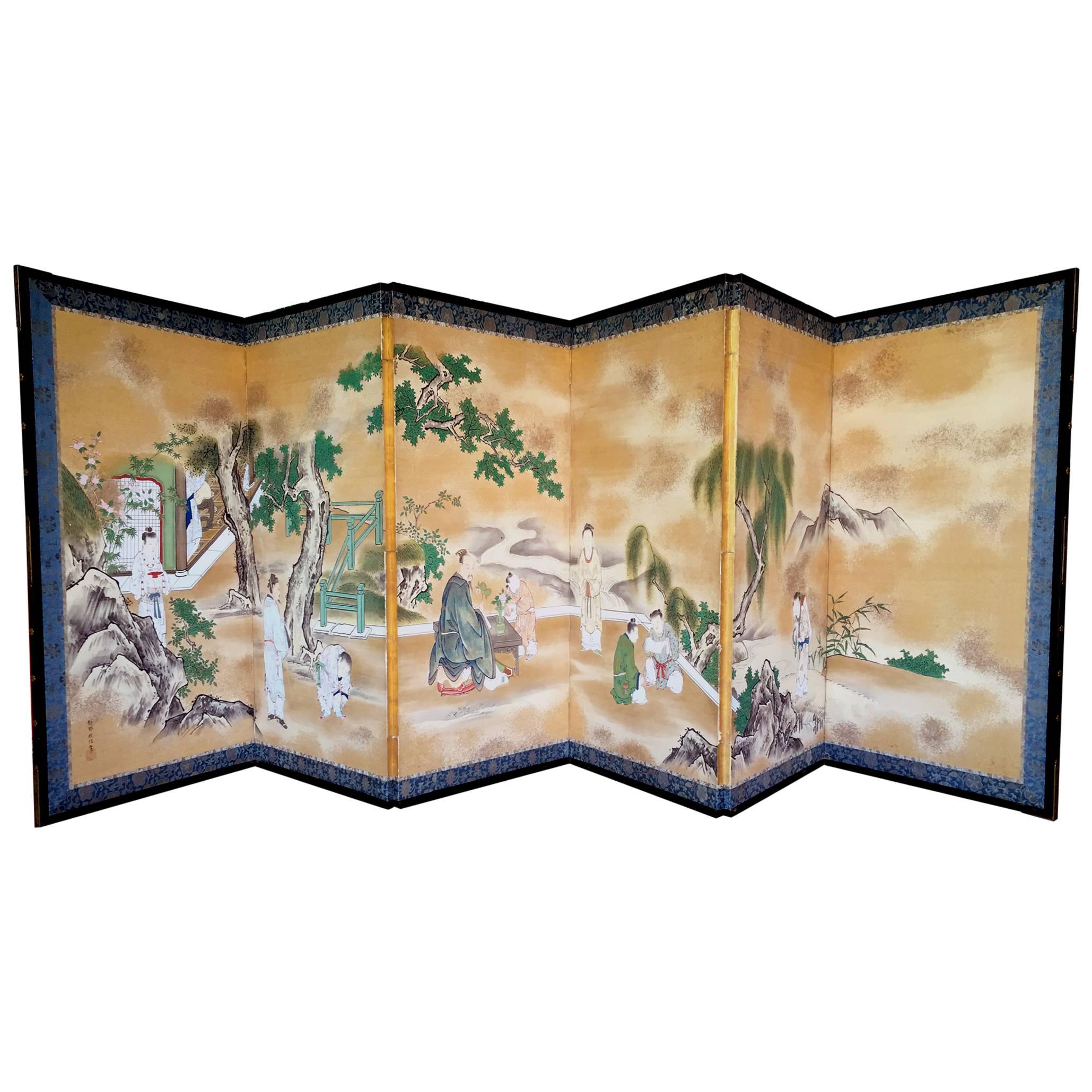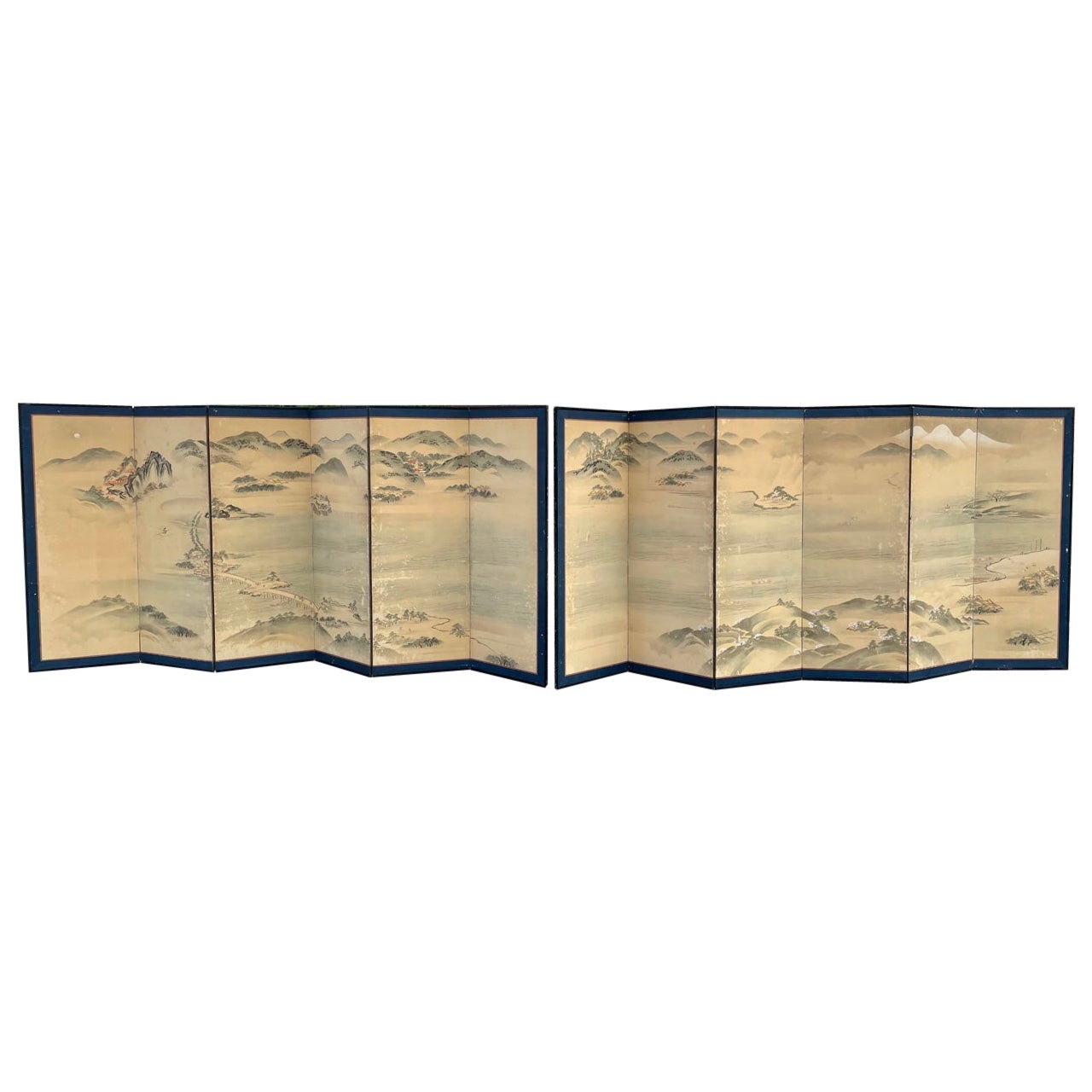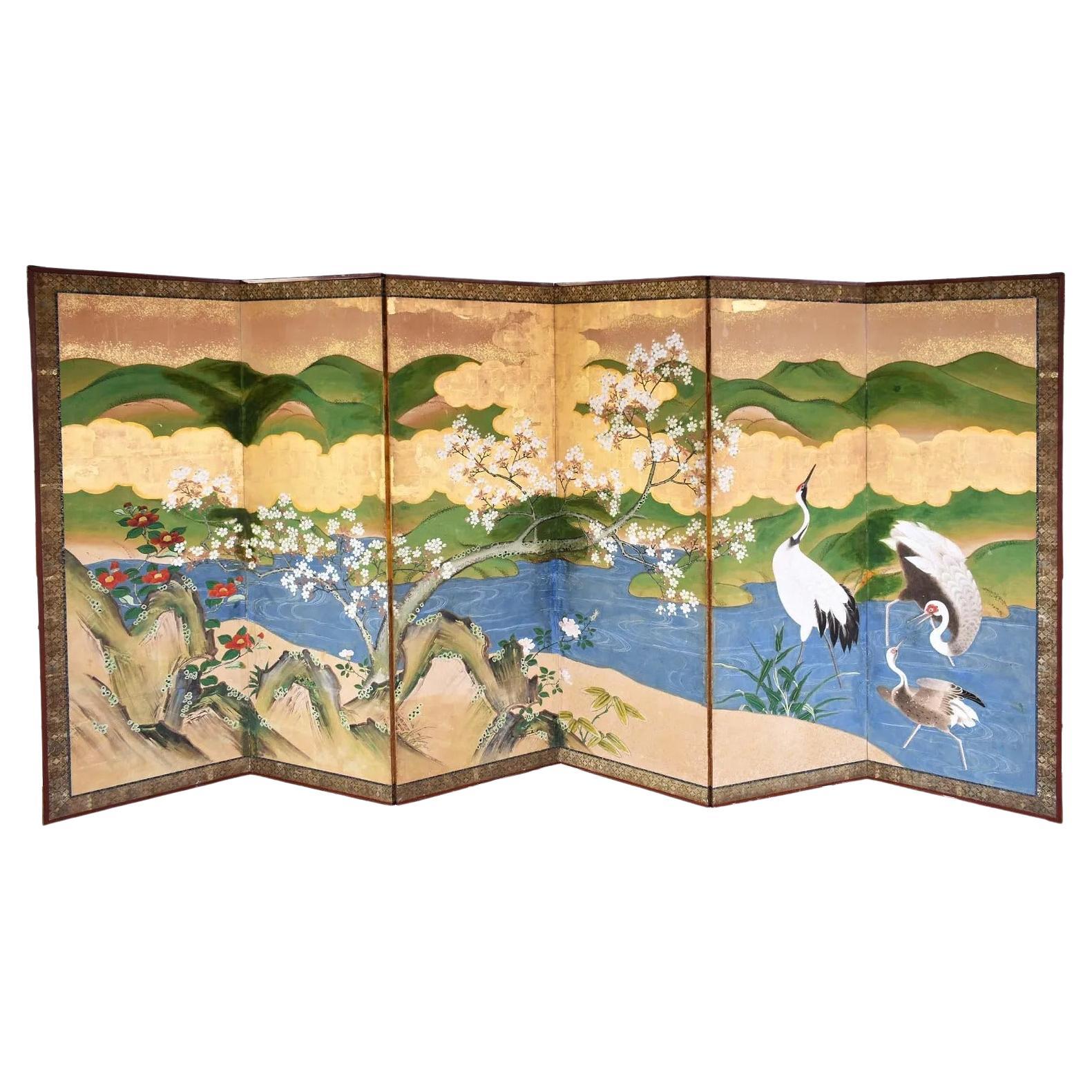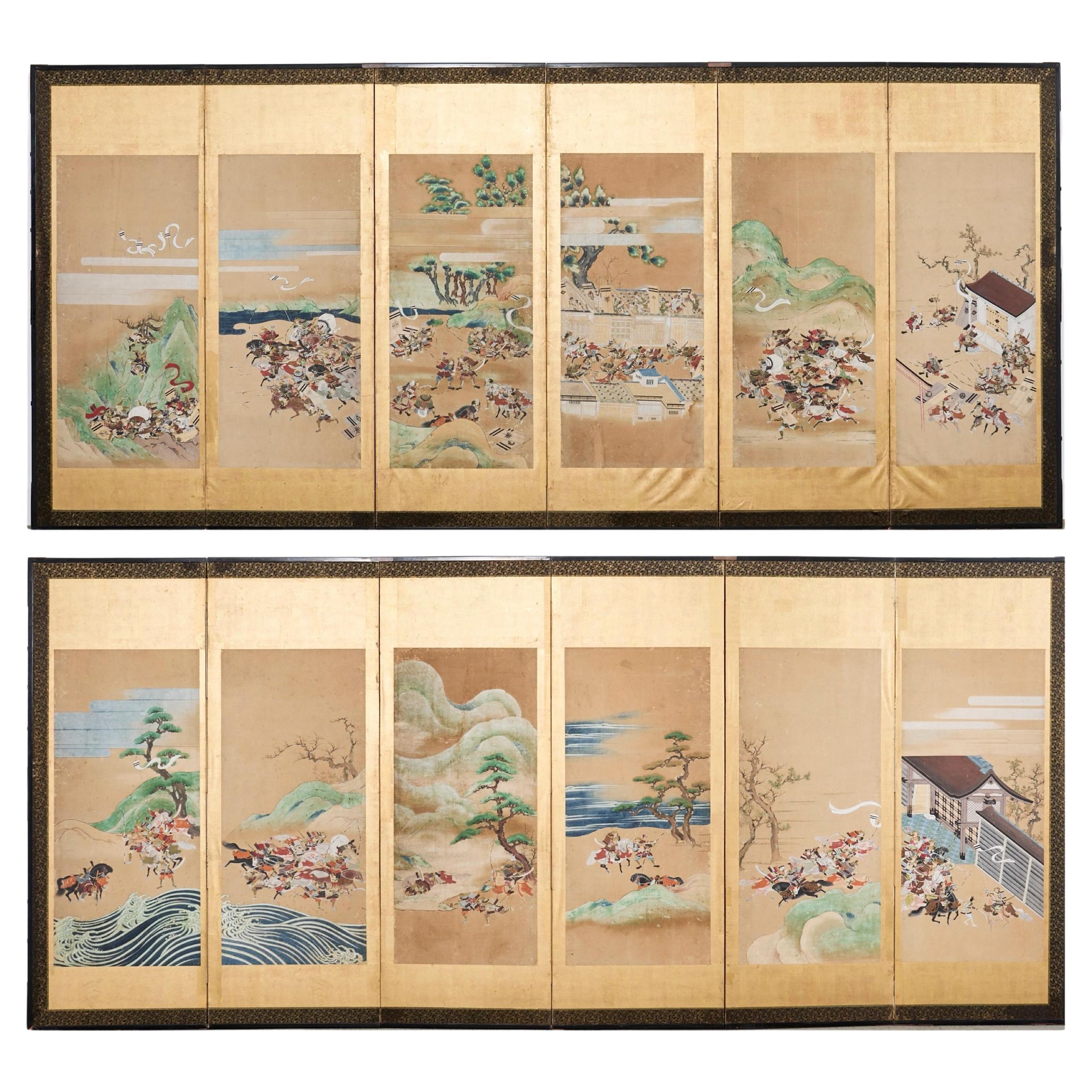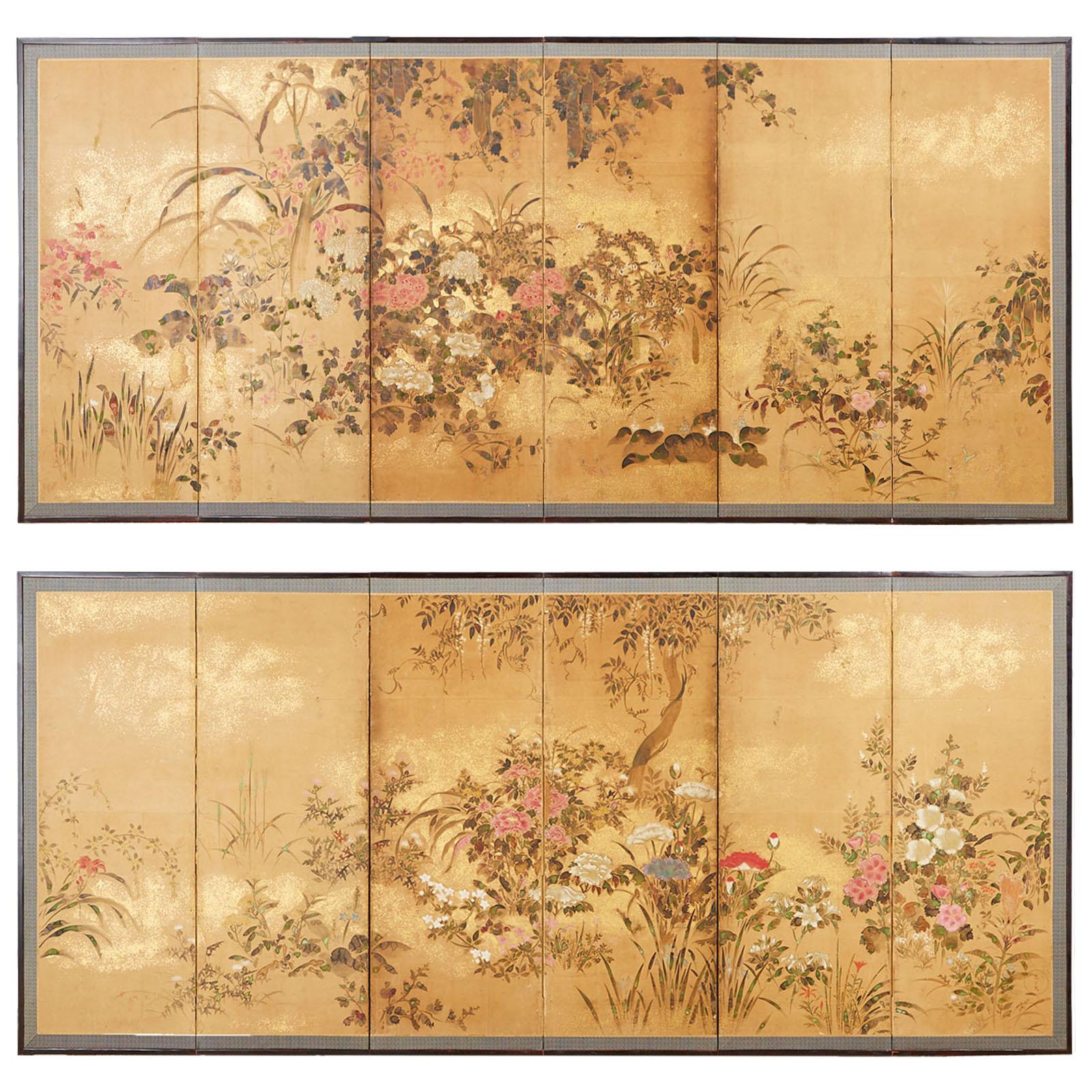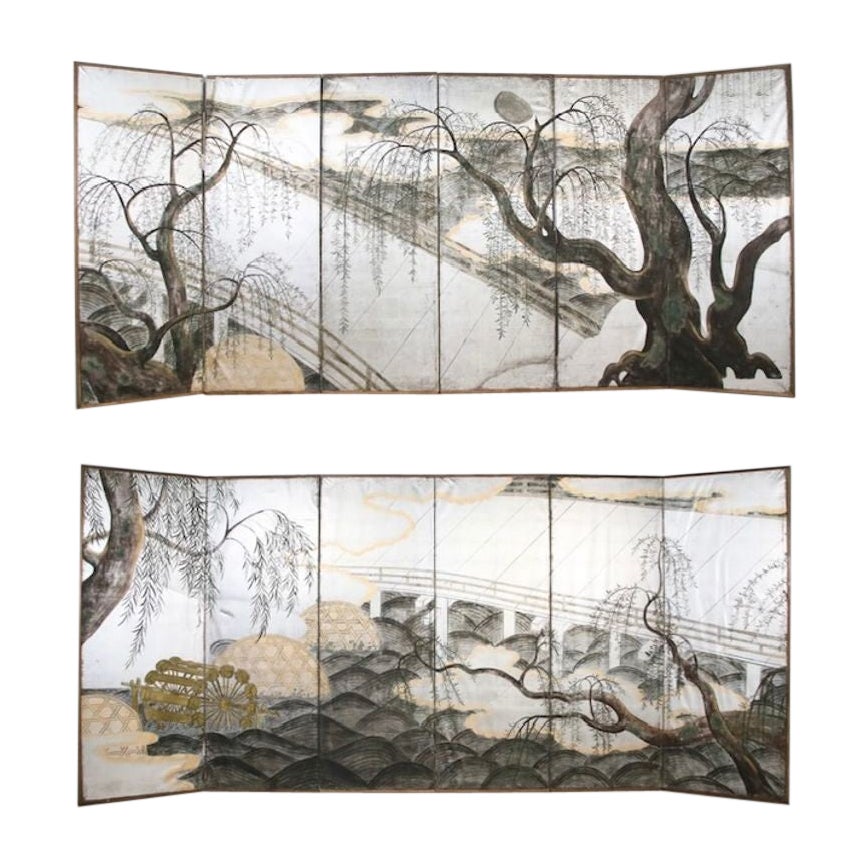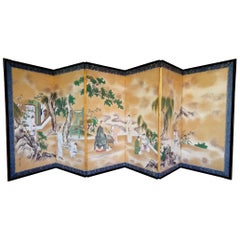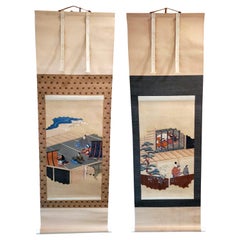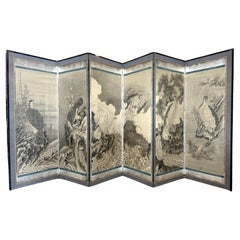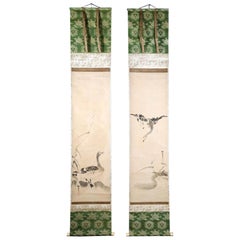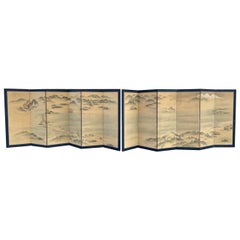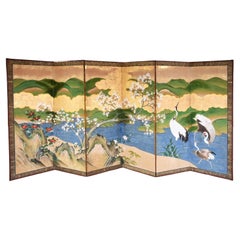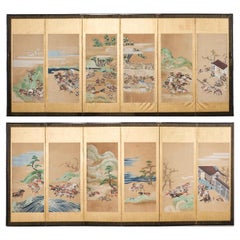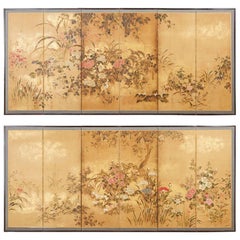Items Similar to Pair of Rare Antique Japanese Folding Screens with Provenance
Want more images or videos?
Request additional images or videos from the seller
1 of 11
Pair of Rare Antique Japanese Folding Screens with Provenance
$22,000per set
£16,705.12per set
€19,103.55per set
CA$30,737.19per set
A$34,186.46per set
CHF 17,851.11per set
MX$416,012.92per set
NOK 227,985.91per set
SEK 213,810.56per set
DKK 142,577.14per set
Shipping
Retrieving quote...The 1stDibs Promise:
Authenticity Guarantee,
Money-Back Guarantee,
24-Hour Cancellation
About the Item
An amazing pair of matching antique Japanese folding screen predating 1812-1813, most likely from Kano School. Six panels each depict Chinese-inspired landscapes showing cranes, pines, peonies, cherry blossoms, mountains and water, all symbols of prosperity and longevity, decorated with splashed gold leaf. Amazingly, the screens come with an original period fitted pine wood case. Under the cover, it has hand-written with note describing the location of the warehouse as well as the date of the storage with the Japanese reign mark dated 1812. An original receipt from a NYC gallery dated 1985 is also included.
- Dimensions:Height: 32 in (81.28 cm)Width: 90 in (228.6 cm)Depth: 0.5 in (1.27 cm)
- Sold As:Set of 2
- Style:Japonisme (Of the Period)
- Materials and Techniques:
- Place of Origin:
- Period:
- Date of Manufacture:Pre-1812
- Condition:Wear consistent with age and use. Very fine original antique condition with three minor scrapes/Punctures on the paper close to the folding area. No tear or rip. wear on wood frame and oxidation on brass hardware. Original period wood box.
- Seller Location:Atlanta, GA
- Reference Number:1stDibs: LU90454830883
About the Seller
4.9
Platinum Seller
Premium sellers with a 4.7+ rating and 24-hour response times
Established in 2006
1stDibs seller since 2010
564 sales on 1stDibs
Typical response time: <1 hour
- ShippingRetrieving quote...Shipping from: Atlanta, GA
- Return Policy
Authenticity Guarantee
In the unlikely event there’s an issue with an item’s authenticity, contact us within 1 year for a full refund. DetailsMoney-Back Guarantee
If your item is not as described, is damaged in transit, or does not arrive, contact us within 7 days for a full refund. Details24-Hour Cancellation
You have a 24-hour grace period in which to reconsider your purchase, with no questions asked.Vetted Professional Sellers
Our world-class sellers must adhere to strict standards for service and quality, maintaining the integrity of our listings.Price-Match Guarantee
If you find that a seller listed the same item for a lower price elsewhere, we’ll match it.Trusted Global Delivery
Our best-in-class carrier network provides specialized shipping options worldwide, including custom delivery.More From This Seller
View AllRare Antique Japanese Folding Screen by Kano Tanshin
By Kano Tanshin
Located in Atlanta, GA
An exquisite Japanese folding screen painted and signed by Kano Tanshin (Morimasa) (1658-1719), circa early Edo Period. An important member of the Kano painter family, the son of Kano Tanyu...
Category
Antique 17th Century Japanese Japonisme Paintings and Screens
Materials
Brass
Two Antique Japanese Hanging Scroll Paintings
Located in Atlanta, GA
Two Japanese scroll painting depicts scenes from the Tale of Genji (Genji-E), from Edo period. These painting were purchased from Odewara Shoten in the...
Category
Antique Early 19th Century Japanese Japonisme Paintings and Screens
Materials
Brocade, Paper
$4,800 / set
Rare Japanese Floor Screen of Perched Eagles Soga Shohaku Edo period
Located in Atlanta, GA
A rare six-panel Japanese folding floor screen (Byōbu) by Soga Shōhaku (1730-1781) from Edo period. The screen depicts six perched hawk-eagles in various poses positioned in a litera...
Category
Antique 18th Century Japanese Edo Paintings and Screens
Materials
Brocade, Wood, Paper
Pair of Japanese Ink Hanging Scrolls Kano Tanyu
By Kano Tan'yu 1
Located in Atlanta, GA
A fine matching pair of hanging scrolls ink on paper mounted in green brocade borders circa Edo period (17-18th century). The Kano school painting depicts wild geese in the reeds by the margin of water, a popular subject borrowed from the Chinese tradition. Both painting were signed as Tanyu with a red seal of Morinobu, his birth name. The storage box is also present and was inscribed with the title Painting of Geese and Reeds and Kano Tanyu...
Category
Antique Late 17th Century Japanese Japonisme Paintings and Screens
Materials
Wood, Paper
$6,000 / set
Japanese Silk Scroll Painting of Moneys Edo Period Mori Tetsuzan
Located in Atlanta, GA
A Japanese mounted vertical hanging scroll painting by Mori Tetsuzan (Japanese, 1775-1841) circa 19th century Edo period. The watercolor and ink on silk ...
Category
Antique 19th Century Japanese Japonisme Paintings and Screens
Materials
Silk, Paper
Korean Folding Chaekgeori Painted Scholar Floor Screen
Located in Atlanta, GA
A six-panel painted folding floor screen from Korea circa early 20th century. This type of screen is called Chaekgeori (books and things) which is quite unique to Korea. It became popular at the end of 18th century favored and encouraged by King Jeongjo (1752-1800) as a political tool to promote social conservatism such as the traditional Confucianism value, especially considered important in a time when waves of new ideology influx came to Korea. Initially commissioned for the royal court, they became increasingly popular with the scholars of noble and affluent households and were used widely in their halls and studies. Early screens were painted with trompe-l’oeil bookcases displaying books and arrays of collectibles. Later, the bookcases were eliminated to focus on the assemblage of neatly stacked books and objects of scholarly pursue. On this screen, the six panels were neatly presented and framed in woven brocade borders. Among the stacked volumes, one can find many fine porcelain vases with flowers, potted orchids, pen holders with brush pens and scroll paintings, incense burner, ink stone, teapot, fan with ink painting, vessels of fruits, exotic plants such as lotus, plumeria and even a pair of glasses. It feels like a pleasant visual measure hunting for the viewers. Several words in Chinese found their way into the picture as well, including filial (xiao), longevity (shou) and luck (fu).
The painting was done in a meticulous way with no details overlooked and also with a rather western still-life dimensional perspective. In a rather unusual maximal but also minimalistic way, the screen exudes a historical charm with a folky flair but appears modern at the same time.
Each panel is 17.5"w by 70.2"h.
For general information on the subject see reference: Chaekgeori the Power and Pleasure of Possessions in Korean Painted Screens...
Category
20th Century Korean Folk Art Paintings and Screens
Materials
Brocade, Silk, Wood, Paper
You May Also Like
Pair of 19th Century Japanese Screens
Located in Bagshot, GB
A pair of large 19th century Japanses Screens of Japanese scenery.
The screens also come with a wooden crate which would have been built for them at a later date in order to move ...
Category
Antique 19th Century Asian Other Decorative Art
Materials
Paper
$3,647 Sale Price / set
30% Off
Vintage Meiji Period Six Panel Japanese Folding Screen
Located in Locust Valley, NY
A super chic and beautifully done Vintage Meiji Period Six Panel Japanese Folding Screen Depicting Cranes in Continuous Landscape With Blossoming Foliage...
Category
Antique Late 19th Century Unknown Meiji Paintings and Screens
Materials
Brass
Pair of Japanese Edo/Tokugawa Screens Tale of Heiki
Located in Rio Vista, CA
Monumental pair of late 18th century Japanese Edo/Tokugawa period byobu screens depicting the battles between Taira and Minamoto. The screens have six panels each with individual sce...
Category
Antique 19th Century Japanese Edo Paintings and Screens
Materials
Brass, Gold Leaf
Pair of Japanese Edo Rimpa School Screens after Tawaraya Sōtatsu
Located in Rio Vista, CA
Impressive pair of 17th century Japanese Edo period Rinpa school screens made in the manner and style of Autumn Grasses by Tawaraya Sōtatsu (1570-1640). Beautifully decorated with wi...
Category
Antique 17th Century Japanese Edo Paintings and Screens
Materials
Gold Leaf
Pair of Japanese Silver Leaf Meiji Period Painted Screens
Located in Dallas, TX
The product is a pair of Japanese silver leaf Meiji period painted screens. These screens showcase intricate artwork and designs typical of the Me...
Category
Antique 19th Century Japanese Paintings and Screens
Materials
Wood
Japanese Asian Pair of Large Six-Panel Folding Byobu Screens Mythical Landscape
Located in Studio City, CA
A beautiful, alluring, wonderfully composed and engaging hand-painted large pair of six-panel Japanese/Asian Byobu folding screens depicting an almost magical/ mythical village scene...
Category
Antique 18th Century Japanese Meiji Paintings and Screens
Materials
Gold Leaf
More Ways To Browse
1812 Furniture
Antique Folding Screen
Pair Of Japanese Screens
Antique Asian Folding Screen
Kano School
Gold Crane Japanese
Pair Antique Landscape Paintings
Folding Screen Gold Leaf
Japanese Kano Screen
Japanese Screen Gold Landscape
Rare Chinese Screens
Crane Screen
Japanese Screen Kano School
Kano School Screen
Antique Japanese Wood Screens
Japanese Screens Pines
Antique Chinese Folding Screens
Pair Of Chinese Cranes
